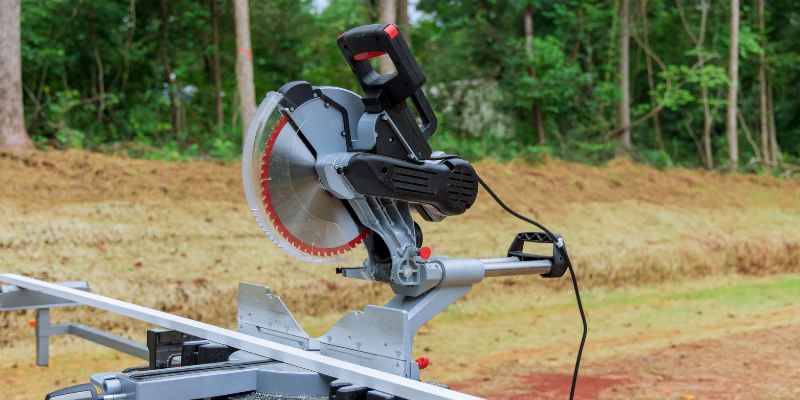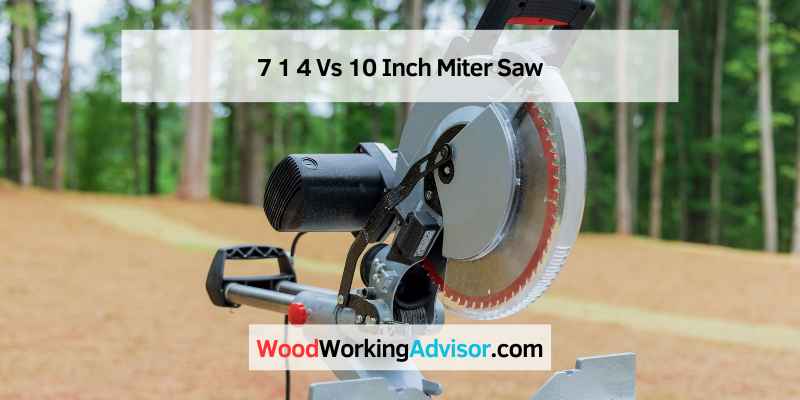There are a few things to consider when choosing between a 7 1/4 inch and 10 inch miter saw. The most important thing is the size of the blade. The larger the blade, the more powerful the saw.
However, this also means that the saw is heavier and more difficult to maneuver. If you’ll be using your saw for large projects, then a 10 inch miter saw is probably a better choice. But if you’re only going to be doing smaller projects, then a 7 1/4 inch miter saw will suffice.
Another thing to consider is the price. A 10 inch miter saw will definitely cost more than a 7 1/4 inch miter saw. So if price is an issue, then go with the smaller model.
There are a few things to consider when choosing between a 7 1/4 inch and 10 inch miter saw. The first is the size of the blade. A 7 1/4 inch blade is going to be smaller than a 10 inch blade.
This means that it can make smaller cuts and will be less powerful. However, it also means that it is more maneuverable and easier to control. If you need to make precision cuts, then a smaller blade might be the way to go.
The second thing to consider is the price. A 10 inch miter saw is going to be more expensive than a 7 1/4 inch miter saw. This is because they are bigger and more powerful.
If you have the budget for it, then a 10 inch miter saw would be the better choice. However, if you are on a tight budget, then a 7 1/4 inch miter saw might be all you need. In conclusion, there are pros and cons to both types of miter saws.

8 Or 10 Inch Mitre Saw
When it comes to choosing a mitre saw, one of the most important decisions is the blade size. There are two common sizes available – 8 inch and 10 inch. So, which one should you choose?
The answer really depends on the specific project you’re working on. For example, if you’re cutting large pieces of lumber or trim, then a 10 inch blade will be more suitable. However, if you’re working on smaller projects or need to make more precise cuts, then an 8 inch blade would be the better option.
Of course, there are also other factors to consider when choosing a mitre saw such as power, features and price. But in terms of blade size, it really comes down to personal preference and the specific project you’re working on.
Best 7-1/4 Sliding Miter Saw Corded
If you’re looking for a durable and powerful corded sliding miter saw, the 7-1/4″ model is a great option. With a powerful motor and large blade, this saw can handle even the most challenging cuts. And, thanks to the sliding mechanism, you’ll be able to make long cuts with ease.
10-Inch Sliding Compound Miter Saw Cut Capacity
When you need to make precision cuts, a 10-inch sliding compound miter saw is the tool for the job. This type of saw is designed for making clean, straight cuts in wood and other materials. The blade on a 10-inch sliding compound miter saw can be moved forward and backward, as well as up and down, allowing you to make angled cuts.
Most 10-inch sliding compound miter saws have a laser guide that projects a line onto the workpiece, making it easier to see where the blade will cut. Some models also have an LED light that illuminates the cutting area. These features can be very helpful when working in low-light conditions.
When choosing a 10-inch sliding compound miter saw, pay attention to the maximum cutting capacity. This is the thickness of material that the saw can handle. For most home projects, a saw with a 12-inch maximum cutting capacity should be sufficient.
However, if you plan on doing some heavy-duty work, such as trimming thick lumber or cutting large pieces of plywood, look for a model with a 14- or 16-inch maximum cutting capacity.
7 1/4” Miter Saw Worth It
Are you looking for a powerful and accurate miter saw? If so, you may be wondering if the 7 1/4” Miter Saw is worth the investment.
This saw is a great option for anyone who needs a durable and reliable tool.
It is made with a heavy duty motor that delivers plenty of power to make clean cuts through even the toughest materials. The blade is also designed to stay sharp for long periods of time, so you won’t have to worry about replacing it often.
In terms of accuracy, the 7 1/4” Miter Saw is second to none.
It features an adjustable laser guide that makes it easy to get precise cuts every time. You can also adjust the bevel and miter angles to suit your specific needs.
Overall, the 7 1/4” Miter Saw is a great choice for anyone in need of a high-quality and accurate tool.
It’s definitely worth the investment!
7 1/4 Sliding Miter Saw Cut Capacity
When it comes to making precision cuts, a sliding miter saw is hard to beat. And when you need to make long or wide cuts, a sliding miter saw really comes in handy. But what is the maximum cut width or depth that you can expect from a 7 1/4″ sliding miter saw?
The answer may surprise you. Most 7 1/4″ sliding miter saws have a maximum cutting depth of 2-3/8″, which is plenty for most trim work and other general woodworking tasks. However, there are some models that have a maximum cutting depth of 4″.
So, if you need to make longer or wider cuts, be sure to check the specs on your particular model of saw before you buy it. And if you’re not sure, just ask one of our experts at The Home Depot. We’ll be happy to help you find the right tool for the job.
7 1/4 Miter Saw
If you’re in the market for a miter saw, one option you may come across is the 7 1/4″ model. In this blog post, we’ll take a close look at this type of miter saw and what it has to offer so that you can decide if it’s the right tool for your needs. The first thing to know about a 7 1/4″ miter saw is that it’s designed for making cross cuts in material.
This means that it’s ideal for cutting boards and trim pieces to size. It’s also capable of making beveled cuts, which can come in handy when working on projects that require angled cuts. One of the main benefits of opting for a 7 1/4″ miter saw over other models is its compact size.
This makes it easier to transport and store, which can be a major plus if you have limited space in your workshop or garage. Additionally, its smaller footprint means that it won’t take up as much room on your workbench when you’re using it. Another advantage of this type of miter saw is that it typically comes with a laser guide.
This feature helps ensure that your cuts are accurate by providing a visual reference line to follow as you make your cut. Not all models include this feature, so if accuracy is important to you, make sure to choose a saw that has it. As with any power tool, there are some potential downsides to consider before purchasing a 7 1/4″ miter saw.
One thing to keep in mind is that because of its smaller size, this type of saw may not have the power needed to tackle larger projects or tougher materials like hardwoods. Additionally, the blades on these types of saws are also smaller than those on other models, so they may not last as long before needing to be replaced.
12-Inch Sliding Miter Saw Cut Capacity
A 12-inch sliding miter saw is a great tool for making long, precise cuts. It can handle boards up to 12 inches wide and 8 feet long. The saw has a built-in laser guide that makes it easy to line up your cut, and the adjustable blade can be set at any angle from 0 to 45 degrees.
7 Inch Compound Miter Saw
A 7 inch compound miter saw is a versatile tool that can be used for a variety of projects. It can be used to cut wood, metal, or plastic. The blade can be adjusted to make different types of cuts, such as crosscuts, rip cuts, and miter cuts.
This saw is also equipped with a dust collector to help keep your workspace clean.

Credit: www.reddit.com
How Wide Can a 7 1 4 Miter Saw Cut?
Most miter saws can cut up to a 45-degree angle to the left or right. The width of the blade determines how wide of a cut you can make. A 7 1/4 inch blade can cut up to 2 3/8 inches wide.
Will a 7 1 4 Sliding Miter Saw Cut a 4X4?
A 7 1/4-inch sliding miter saw can cut through a 4×4 in a single pass. The depth of the cut will be determined by the position of the blade, but it will typically be about 3 inches. Make sure to use a blade that is designed for cutting wood, and not metal or concrete.
Also, be sure to support the weight of the 4×4 so that it does not tip over while you are cutting it.
Will a 7 1 4 Miter Saw Cut a 2X6?
If you’re looking to cut a 2×6 with a miter saw, you’ll be glad to know that most 7 1/4″ miter saws can handle this job. Just be sure to double check the specifications of your particular model to ensure that it can cut through a 2×6. When making your cuts, you may need to adjust the depth of your blade in order to get a clean, precise cut.
But with a little bit of practice, you should be able to make all the cuts you need with ease.
Is Bigger Mitre Saw Better Than Smaller One?
No, not necessarily. It depends on what you need it for. If you have a small workspace and need to make precision cuts, then a smaller saw would be better.
If you have a large workspace and need to make long cuts, then a bigger saw would be better.
Conclusion
A miter saw is a power tool that can make precise crosscuts and miters in wood. It’s a versatile tool that can be used for many different projects, including trim work, cabinetry, and frame construction. There are two common types of miter saws: the 7-1/4 inch and the 10 inch.
Both sizes have their own advantages and disadvantages, so it’s important to choose the right one for your needs. Here’s a look at the 7-1/4 inch vs 10 inch miter saws to help you decide which is best for you. 7-1/4 Inch Miter Saws
Advantages: + More compact than 10″ models – easier to transport and store + Usually lighter weight – easier to maneuver around the job site
+ Lower price point
Disadvantages: – Limited cutting capacity – cannot make wide or deep cuts



One thought on “7 1 4 Vs 10 Inch Miter Saw”